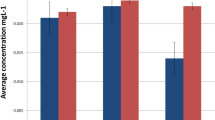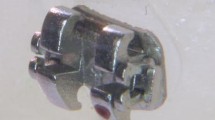Abstract
Objectives
Quantify metal ion release in the saliva, considering that orthodontic appliances with soldered or welded parts may suffer corrosion and release metal ions into saliva, which can trigger adverse effects, such as hypersensitivity.
Methods
Sixty-four patients were distributed into four groups: G1 (control), G2 (silver-soldered lingual arch), G3 (laser-welded lingual arch), and G4 (TIG-welded lingual arch). Saliva samples were collected at four different points and were analyzed for ion release with ICP-MS.
Results
For Cr, Fe, Cu, and Sn ion concentrations among groups, there was no difference along collections and no statistically significant difference throughout collections for any group (P > 0.05, with release values between 3.3 and 4.2 μg/L for Cr, 201 and 314.8 μg/L for Fe, 23.1 and 40.7 μg/L for Cu, and 13 and 27.7 μg/L for Sn). For Ni, G4 showed an increased ion release at T2 (14.3 μg/L) and T4 (34.5 μg/L), values with an interaction effect (P < 0.001) comparing the groups and the points of collection. For Zn, Ag, and Cd ions there was no difference along the points in time (P > 0.05). For Zn ions, there was a statistic difference from G4 to G1 and G2 (P = 0.007 and P = 0.019), with median values ranging from 741.7 to 963.4 μg/L for G4, and for Ag ions, from G4 to G2 and G3 (P < 0.001 for both), with lower medians for G4 (3.7–6.1 μg/L). For Cd ions there was a statistic difference from T1 to T4 in all groups (P = 0.016), with lower values for T4.
Conclusions
Different welding procedures may affect salivary ion concentrations. For most ions there was no significant increase comparing welding and comparing throughout points in the same group. Although TIG welding presented greater Ni ion release, this possibly occurred due to a bigger corrosion of the welded.
Clinical relevance
Determining the amount of released metal ions from the use of orthodontic appliances is relevant to ensure the safest method for patients. Welding procedures affect salivary ion concentrations, when comparing ion release triggered by one of the most common devices used for preventive/interceptive orthodontic treatments.




Similar content being viewed by others
References
Williams DF (2008) On the mechanisms of biocompatibility. Biomaterials 29:2941–2953
Menezes LM, Quintão CCA (2010) The release of ions from metallic orthodontic appliances. Semin Orthod 16:282–292
Sifakakis I, Eliades T (2017) Adverse reactions to orthodontic materials. Aust Dent J 62(Suppl 1):20–28
House K, Sernetz F, Dymock D, Sandy JR, Ireland AJ (2008) Corrosion of orthodontic appliances–should we care? Am J Orthod Dentofac Orthop 133:584–592
Kuhta M, Pavlin D, Slaj M, Varga S, Lapter-Varga M (2009) Type of archwire and level of acidity: effects on the release of metal ions from orthodontic appliances. Angle Orthod 79:102–110
Maijer R, Smith DC (1986) Biodegradation of the orthodontic bracket system. Am J Orthod Dentofac Orthop 90:195–198
Faccioni F, Franceschetti P, Cerpelloni M, Fracasso ME (2003) In vivo study on metal release from fixed orthodontic appliances and DNA damage in oral mucosa cells. Am J Orthod Dentofac Orthop 124:687–693 discussion 693-684
Hafez HS, Selim EM, Kamel Eid FH, Tawfik WA, Al-Ashkar EA, Mostafa YA (2011) Cytotoxicity, genotoxicity, and metal release in patients with fixed orthodontic appliances: a longitudinal in-vivo study. Am J Orthod Dentofac Orthop 140:298–308
Natarajan M, Padmanabhan S, Chitharanjan A, Narasimhan M (2011) Evaluation of the genotoxic effects of fixed appliances on oral mucosal cells and the relationship to nickel and chromium concentrations: an in-vivo study. Am J Orthod Dentofac Orthop 140:383–388
Nayak RS, Khanna B, Pasha A, Vinay K, Narayan A, Chaitra K (2015) Evaluation of nickel and chromium ion release during fixed orthodontic treatment using inductively coupled plasma-mass spectrometer: an in vivo study. J Int Oral Health 7:14–20
Dwivedi A, Tikku T, Khanna R, Maurya RP, Verma G, Murthy RC (2015) Release of nickel and chromium ions in the saliva of patients with fixed orthodontic appliance: an in-vivo study. Natl J Maxillofac Surg 6:62–66
Amini F, Jafari A, Amini P, Sepasi S (2012) Metal ion release from fixed orthodontic appliances--an in vivo study. Eur J Orthod 34:126–130
Freitas MP, Oshima HM, Menezes LM (2011) Release of toxic ions from silver solder used in orthodontics: an in-situ evaluation. Am J Orthod Dentofac Orthop 140:177–181
Jamshidi S, Rahmati Kamel M, Mirzaie M, Sarrafan A, Khafri S, Parsian H (2018) Evaluation of scalp hair nickel and chromium level changes in patients with fixed orthodontic appliance: a one-year follow-up study. Acta Odontol Scand 76:1–5
Grimsdottir MR, Gjerdet NR, Hensten-Pettersen A (1992) Composition and in vitro corrosion of orthodontic appliances. Am J Orthod Dentofac Orthop 101:525–532
Freitas MP, Oshima HM, Menezes LM, Machado DC, Viezzer C (2009) Cytotoxicity of silver solder employed in orthodontics. Angle Orthod 79:939–944
Gonçalves TS, de Menezes LM, Ribeiro LG, Lindholz CG, Medina-Silva R (2014) Differences of cytotoxicity of orthodontic bands assessed by survival tests in Saccharomyces cerevisiae. Biomed Res Int 2014:143283
Mikulewicz M, Chojnacka K, Woźniak B, Downarowicz P (2012) Release of metal ions from orthodontic appliances: an in vitro study. Biol Trace Elem Res 146:272–280
Matos IC, Bastos IN, Diniz MG, de Miranda MS (2015) Corrosion in artificial saliva of a Ni-Cr-based dental alloy joined by TIG welding and conventional brazing. J Prosthet Dent 114:278–285
Mockers O, Deroze D, Camps J (2002) Cytotoxicity of orthodontic bands, brackets and archwires in vitro. Dent Mater 18:311–317
von Fraunhofer JA (1997) Corrosion of orthodontic devices. Semin Orthod 3:198–205
Erdogan AT, Nalbantgil D, Ulkur F, Sahin F (2015) Metal ion release from silver soldering and laser welding caused by different types of mouthwash. Angle Orthod 85:665–672
Hurt AJ (2012) Digital technology in the orthodontic laboratory. Am J Orthod Dentofac Orthop 141:245–247
Solmi R, Martini D, Zanarini M, Isaza Penco S, Rimondini L, Carinci P, Borea G, Ruggeri A (2004) Interactions of fibroblasts with soldered and laser-welded joints. Biomaterials 25:735–740
Sestini S, Notarantonio L, Cerboni B, Alessandrini C, Fimiani M, Nannelli P, Pelagalli A, Giorgetti R (2006) In vitro toxicity evaluation of silver soldering, electrical resistance, and laser welding of orthodontic wires. Eur J Orthod 28:567–572
Atiki E, Dursun C, Akcan CA, El H, Tözüm TF, Ciger S (2014) The comparison of silver and laser soldering techniques on periodontal tissues: a preliminary study. Turkish J Orthodontics 27:70–75
Wang RR, Welsch GE (1995) Joining titanium materials with tungsten inert gas welding, laser welding, and infrared brazing. J Prosthet Dent 74:521–530
Bock JJ, Bailly J, Fuhrmann RA (2009) Effects of different brazing and welding methods on the fracture load of various orthodontic joining configurations. J Orthod 36:78–84
Rocha R, Pinheiro AL, Villaverde AB (2006) Flexural strength of pure Ti, Ni-Cr and Co-Cr alloys submitted to Nd:YAG laser or TIG welding. Braz Dent J 17:20–23
Dadfar M, Fathi MH, Karimzadeh F, Dadfar MR, Saatchi A (2007) Effect of TIG welding on corrosion behavior of 316L stainless steel. Mater Lett 61:2343–2346
Bock JJ, Fraenzel W, Bailly J, Gernhardt CR, Fuhrmann RA (2008) Influence of different brazing and welding methods on tensile strength and microhardness of orthodontic stainless steel wire. Eur J Orthod 30:396–400
Gölz L, Knickenberg AC, Keilig L, Reimann S, Papageorgiou SN, Jäger A, Bourauel C (2016) Nickel ion concentrations in the saliva of patients treated with self-ligating fixed appliances: a prospective cohort study. J Orofac Orthop 77:85–93
Quadras DD, Nayak USK, Kumari NS, Priyadarshini HR, Gowda S, Fernandes B (2019) In vivo study on the release of nickel, chromium, and zinc in saliva and serum from patients treated with fixed orthodontic appliances. Dent Res J (Isfahan) 16:209–215
Jacoby LS, Rodrigues Junior VDS, Campos MM, Macedo de Menezes L (2017) Cytotoxic outcomes of orthodontic bands with and without silver solder in different cell lineages. Am J Orthod Dentofac Orthop 151:957–963
Chakravarthi S, Padmanabhan S, Chitharanjan AB (2012) Allergy and orthodontics. J Orthod Sci 1:83–87
Mirhashemi A, Jahangiri S, Kharrazifard M (2018) Release of nickel and chromium ions from orthodontic wires following the use of teeth whitening mouthwashes. Prog Orthod 19:4
Petoumenou E, Arndt M, Keilig L, Reimann S, Hoederath H, Eliades T, Jäger A, Bourauel C (2009) Nickel concentration in the saliva of patients with nickel-titanium orthodontic appliances. Am J Orthod Dentofac Orthop 135:59–65
Kocadereli L, Ataç PA, Kale PS, Ozer D (2000) Salivary nickel and chromium in patients with fixed orthodontic appliances. Angle Orthod 70:431–434
Staffolani N, Damiani F, Lilli C, Guerra M, Staffolani NJ, Belcastro S, Locci P (1999) Ion release from orthodontic appliances. J Dent 27:449–454
Iijima M, Brantley WA, Yuasa T, Muguruma T, Kawashima I, Mizoguchi I (2008) Joining characteristics of orthodontic wires with laser welding. J Biomed Mater Res B Appl Biomater 84:147–153
Hwang CJ, Shin JS, Cha JY (2001) Metal release from simulated fixed orthodontic appliances. Am J Orthod Dentofac Orthop 120:383–391
Bock JJ, Bailly J, Gernhardt CR, Fuhrmann RA (2008) Fracture strength of different soldered and welded orthodontic joining configurations with and without filling material. J Appl Oral Sci 16:328–335
Ağaoğlu G, Arun T, Izgi B, Yarat A, Izgü B (2001) Nickel and chromium levels in the saliva and serum of patients with fixed orthodontic appliances. Angle Orthod 71:375–379
Schroeder HA, Balassa JJ, Tipton IH (1962) Abnormal trace metals in man--nickel. J Chronic Dis 15:51–65
Hensten-Pettersen A, Jacobsen N (1978) Nickel corrosion of non-precious casting alloys and the cytotoxic effect of nickel in vitro. J Bioeng 2:419–425
Catalanatto FA, Sunderman FW (1977) Nickel concentrations in human parotid saliva. Ann Clin Lab Sci 7:146–151
Funding
This study was financed in part by the Coordination for the Improvement of Higher Education Personnel–Coordenação de Aperfeiçoamento de Pessoal de Nível Superior–Brasil (CAPES)–Finance Code 001.
Author information
Authors and Affiliations
Corresponding author
Ethics declarations
Conflict of interest
The authors declare that they have no conflict of interest.
Ethical approval
The study was submitted and approved in the research ethics commitee of Pontifícia Universidade Católica do Rio Grande do Sul (CEP-PUCRS) with the approval number 67430117.7.0000.5336. All procedures performed in studies involving human participants were in accordance with the ethical standards of the institutional research committee and with the 1964 Helsinki declaration and its later amendments or comparable ethical standards.
Informed consent
Informed consent was obtained from all individual participants included in the study.
Additional information
Publisher’s note
Springer Nature remains neutral with regard to jurisdictional claims in published maps and institutional affiliations.
Rights and permissions
About this article
Cite this article
de Souza Schacher, H.R., de Menezes, L.M. Metal ion quantification in the saliva of patients with lingual arch appliances using silver solder, laser, or TIG welding. Clin Oral Invest 24, 2109–2120 (2020). https://doi.org/10.1007/s00784-019-03160-z
Received:
Accepted:
Published:
Issue Date:
DOI: https://doi.org/10.1007/s00784-019-03160-z




